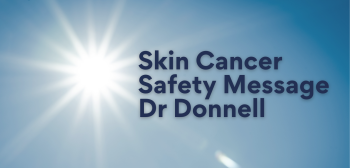12/06/2025

Doctor urges the public to protect themselves against harmful UV exposure as cases of skin cancer are on the rise
Skin Cancer is Northern Ireland’s most common cancer, with roughly 11 new cases diagnosed here each day. In the UK 1 in 4 men and 1 in 5 women will develop a form of skin cancer at least once in their lifetime and the incidence of the most aggressive form of skin cancer, malignant melanoma, is expected to rise by 28% by 2040. While skin cancer is often treatable when caught early, prevention and early detection are key.
As the weather is set to show some improvements again, Dr Ian Donnell, GP registrar working in the Dermatology Department in the Western Trust is using the opportunity to provide his expert advice on preventative measures against skin cancer.
Dr Donnell explains:
“Although Northern Ireland would not be known for having a sunny climate, we have been enjoying some prolonged periods of sun recently, however even without the sun being evident, day-to-day UV exposure, which penetrates clouds and glass, along with the predominant skin types in Northern Ireland combine to give a still very significant risk of developing skin cancer.
“The risk is higher again in people who use sunbeds, the first use of a sun bed under the age of 35 increases the lifetime risk of skin cancer by three quarters. The UV light emitted by tanning devices damages the DNA in skin cells which can lead to the formation of cancerous cells. This is why the International Agency for Research on Cancer classifies the UV light from tanning beds alongside Asbestos and Tobacco in the highest form of cancer-causing agents.”
“Fortunately, 85% of melanomas are avoidable by limiting our exposure to UV. This is best done by protecting yourself from sunlight, particularly during the summer.
“There are many practical ways of doing this, such as seeking shade during the part of the day when the sun is strongest, 1000hrs to 1600hrs, wearing clothes which cover your arms, legs and back of your neck and wearing a hat to protect your face and scalp.”
“Undoubtedly the bedrock of skin cancer prevention is daily, year-round use of a sun protection factor (SPF). Despite these products being available for many years the way in which they work is not well known. Two types of UV radiation from the sun reach earth: UVA and UVB. UVB is the most likely to cause skin cancer.
“The number which follows ‘SPF’ such as ‘SPF 50’ or ‘SPF30’ represents the amount of protection given from UVB rays either by reflecting or absorbing the rays. An SPF 15 blocks 93% of UVB rays, whereas an SPF 50 blocks 99%. However, it is primarily the duration of protection which sets these ratings apart. Obviously, depending on the fairness of our skin, some people will burn quicker than others. SPF 50 will provide 50 times longer protection than the skin’s ability to protect itself. For example, if you are someone whose skin burns after 10 minutes in the sun, wearing an SPF 50 will protect you for 500 minutes, SPF 30 for 300 minutes and so on. However, sun cream should be reapplied every two hours in persistent sun exposure to prevent loss of protection due to sweat or immediately after swimming.”
“UVA can also cause skin cancer and is responsible for ageing and to protect yourself from it you should ensure the product you use is ‘UVA+UVB’ or ‘broad spectrum.”
“Remember to regularly check your skin and contact your GP if you notice new or changing moles or skin lesions.




